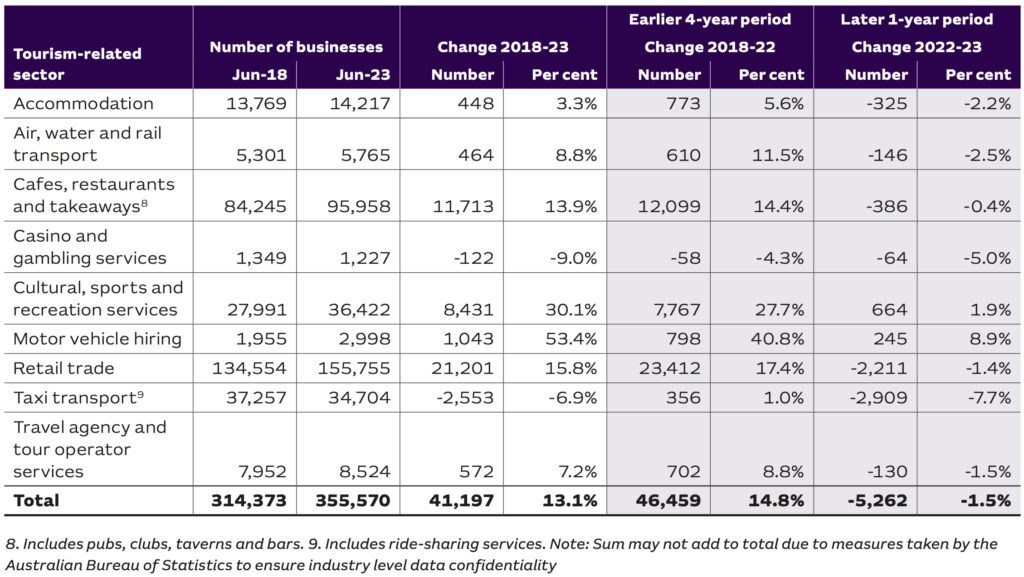It’s a good time to be involved in the travel industry and travel agency sector. Tourism has more or less fully rebounded from the pandemic, air travel is just about back to 2019 levels and airfares are moving in the right direction, while Australia’s busiest hub reports that more Aussies are travelling abroad than in 2019.
But how is all of this great news actually reflected in the number of travel agency and tour operator businesses that are out there right now?
According to Tourism Research Australia’s (TRA) ‘Tourism Businesses in Australia‘ snapshot of the growth of tourism-related businesses over the five years between June 2018 and June 2023, the number of travel agencies and tour operators in Australia grew by 7.2 per cent (+572), from 7,952 to 8,524 businesses.
Considering this came during a pandemic, that’s a healthy rise. Slightly concerning, however, is that during the last of those five years, there was a 1.5 per cent (-130) decline in the number of travel agency and tour operator enterprises across the country.
Perhaps surprisingly, travel agencies and tour operators account for just two per cent of all tourism-related businesses in Australia.
Travel agency challenges

While the increase in the total number of agencies is a positive development for the travel industry, fully staffing those businesses remains a challenge.
According to a recent survey by the Australian Travel Industry Association (ATIA), only one-third of agencies were able to fill all their vacancies for travel agent roles in 2023. That leaves a lot of companies understaffed – and a lot of potential business left on the table.
Compounding the problem, there’s also a skills shortage in certain areas, as highlighted by the Council of Australian Tour Operators’ recent launch of the CATO Touring Academy.
The big picture

In June 2023, Australia had an overall total of 355,570 tourism-related businesses, making up 14 per cent of all Australian enterprises.
These businesses operate across nine different sectors, with the largest four sectors accounting for over 90 per cent of all tourism businesses.
These were retail trade (155,755 businesses, 44 per cent), cafes, restaurants and takeaways (95,958 businesses, 27 per cent), cultural, sports and recreation services (36,422 businesses – 10 per cent), and taxi transport (34,704 businesses – 10 per cent).
Over the five years leading up to June 2023, the number of tourism-related businesses grew by 41,179 (+13 per cent), mainly between 2018 and 2022. However, there was a decline of 5,262 businesses (-1.5 per cent) in the year leading up to June 2023.
Smaller businesses, employing fewer than five people, grew faster than larger businesses between 2018 and 2022 but experienced a decline in the following year.
Growth in tourism businesses in Australia between June 2018 and June 2023

The fastest-growing sectors over the five years were car rentals (+53 per cent), retail trade (+16 per cent), and cafes, restaurants, and takeaways (+14 per cent). Only two sectors, taxi transport and casino and gambling services, saw a decline over this period.
State by state, Victoria (+4.1 per cent), ACT (+3.2 per cent) and the Northern Territory (+2.8 per cent) experienced the fastest growth in tourism businesses over the past five years. But in the final year, Victoria, NT and South Australia had the largest declines.
Additionally, tourism businesses in regional areas grew at a slower rate (+1.9 per cent annually) compared to those in capital cities (+2.7 per cent) over the five-year period, with both regions seeing a decline in the last year.
As of June 2023, Melbourne has the most tourism businesses (79,993), followed by Sydney (78,002), Brisbane (30,100) and Perth (25,058).
The travel industry winners of the 2024 Australian Small Business Champion Awards were recently announced, with Sonia Jones Travel of Ashgrove in Queensland named winner of the 2024 Travel Agency category.










